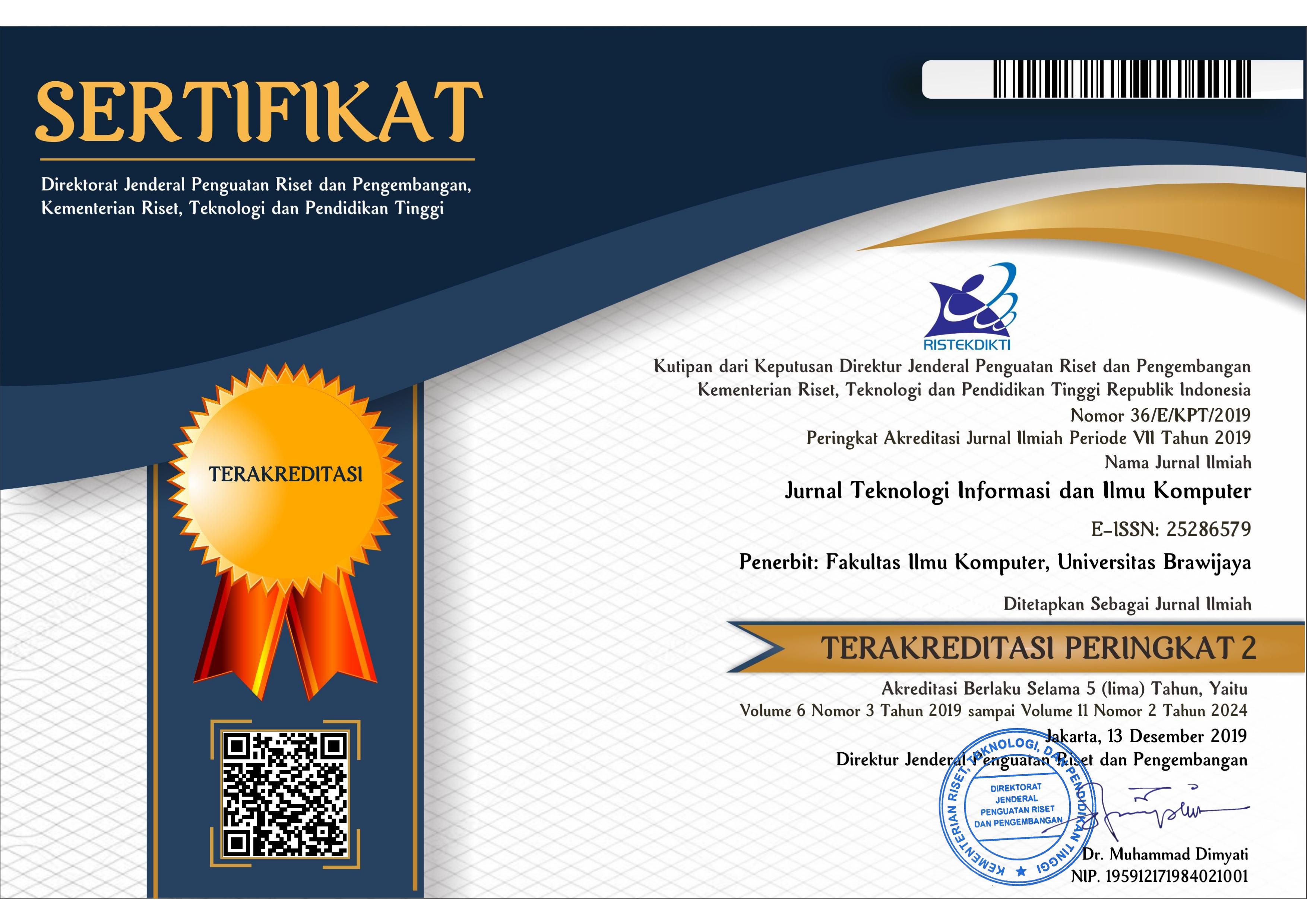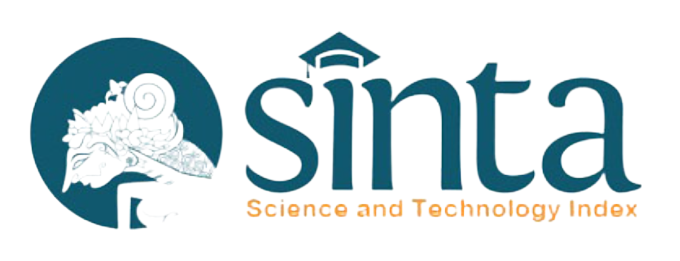Deteksi Detak Jantung Menggunakan Remote Photoplethysmograph dengan Perubahan Jarak dan Jenis Kamera Secara Dinamis
DOI:
https://doi.org/10.25126/jtiik.20241128035Kata Kunci:
Beat per minute, computer vision, detak jantung, PPG, remote photoplethysmograph, rPPGAbstrak
Sinyal Photoplethysmograph (PPG) dapat digunakan untuk mengukur saturasi oksigen dalam darah, tekanan darah dan detak jantung. Metode konvensional yang sering kali digunakan untuk mendeteksi detak jantung, diantaranya: oksimetri, tensimeter, wearable devices seperti smartwatch dan sebagainya. Proses pengukuran dengan menggunakan peralatan konvensional sebagaimana tersebut di atas masih diperlukan kontak secara fisik pada anggota tubuh, jika hal tersebut seringkali dilakukan maka dapat menyebabkan iritasi pada kulit sehingga hal tersebut kurang efektif dan efisien dikarenakan proses interaksinya kurang natural dan intuitif. Pada penelitian ini menerapkan proses deteksi sinyal PPG untuk pembacaan detak jantung melalui dahi secara dinamis menggunakan computer vision secara realtime tanpa diperlukan kontak fisik, konsep tersebut disebut dengan istilah remote PhotoPlethysmoGraph (rPPG). Guna mengetahui seberapa akurat hasil dari pembacaan detak jantung dari metode rPPG maka nilai persentase akurasinya akan dibandingkan dengan hasil pembacaan dari alat oksimetri, smartwatch serta tensimeter digital terbaru dengan koneksi via bluetooth sehingga dapat dimonitor melalui smartphone. Hasil dari penelitian ini persentase akurasi terbaik menggunakan kamera internal laptop didapatkan pada jarak 40 cm dengan pembacaan pada smartwatch sebesar 93,2%, akurasi di oksimeter sebesar 94,4%, sedangkan penggunaan webcam eksternal yang memiliki fitur auto-focus perbandingan rata-rata akurasi metode rPPG terhadap oksimeter sebesar 97,7% dan rata-rata persentase akurasi rPPG terhadap tensimeter digital 99,55%. Metode rPPG dapat dimanfaatkan medis untuk proses skrining awal deteksi detak jantung atau sebagai pendukung keputusan, untuk meningkatkan nilai persentase akurasi dari metode rPPG maka dapat dilakukan beberapa cara, diantaranya: melalui setting dan konfigurasi yang tepat nilai impact factor pada program, penataan pencahayaan dan warna background ruangan.
Abstract
Photoplethysmograph (PPG) signals can measure blood oxygen saturation, blood pressure and heart rate. Conventional methods often used to detect heartbeats include oximetry, blood pressure monitors, wearable devices such as smartwatches, etc. As mentioned above, the measurement process using conventional equipment still requires physical contact with body parts; if this is done frequently, it can cause skin irritation, making it less effective and efficient because the interaction process is less natural and intuitive. In this research, the PPG signal detection process is applied to dynamically read heartbeats through the forehead using computer vision in real-time without physical contact, and this concept is called remote PhotoPlethysmoGraph (rPPG). To find out how accurate the results of heart rate readings from the rPPG method are, the accuracy percentage value will be compared with the reading results from oximetry devices, smartwatches and the latest digital tensimeters with a connection via Bluetooth so that they can be monitored via smartphone. The results of this research were that the best percentage of accuracy using the laptop’s internal camera was obtained at a distance of 40 cm with readings on the smartwatch of 93.2%, accuracy on the oximeter of 94.4% while using an external webcam that had an auto-focus feature compared the average accuracy The rPPG method for oximeters was 97.7% and the average percentage accuracy of rPPG for digital sphygmomanometers was 99.55%. The rPPG method can be used medically for the initial screening process for heartbeat detection or as decision support. Several ways can be done to increase the accuracy percentage value of the Rppg method, including setting and properly configuring the impact factor value in the program, lighting arrangement and room background colour.
Downloads
Referensi
ALLADO, E. et al. 2022. Remote Photoplethysmography Is an Accurate Method to Remotely Measure Respiratory Rate: A Hospital-Based Trial. Journal of clinical medicine, 11(13). doi: 10.3390/jcm11133647.
ALNAEB, M. E. et al. 2007. Optical techniques in the assessment of peripheral arterial disease. Current vascular pharmacology, 5(1), pp. 53–59. doi: 10.2174/157016107779317242.
BABGEI, A. F., SASONGKO, M. W. and Sardjono, T. A. 2022. Analisis Photoplethysmography Jarak Jauh dalam berbagai Kondisi Pencahayaan. IJEIS (Indonesian Journal of Electronics and Instrumentation Systems), 12(2), p. 169. doi: 10.22146/ijeis.78715.
DASARI, A. et al. 2021. Evaluation of biases in remote photoplethysmography methods, NPJ digital medicine, 4(1), p. 91. doi: 10.1038/s41746-021-00462-z.
HERTZMAN, A. B. 1938. The Blood Supply Of Various Skin Areas As Estimated By The Photoelectric Plethysmograph. American Journal of Physiology, 124, pp. 328–340. Available at: https://api.semanticscholar.org/CorpusID:102089762.
LIU, S. H. et al. 2020. Classification of photoplethysmographic signal quality with deep convolution neural networks for accurate measurement of cardiac stroke volume. Applied Sciences (Switzerland), 10(13), pp. 1–16. doi: 10.3390/app10134612.
MA, X., TOBÓN, D. P. AND EL SADDIK, A. 2020. Remote Photoplethysmography (rPPG) for Contactless Heart Rate Monitoring Using a Single Monochrome and Color Camera’, in McDaniel, T. et al. (eds) Smart Multimedia. Cham: Springer International Publishing, pp. 248–262.
NILSSON, L., JOHANSSON, A. AND KALMAN, S. 2005. Respiration can be monitored by photoplethysmography with high sensitivity and specificity regardless of anaesthesia and ventilatory mode. Acta anaesthesiologica Scandinavica, 49(8), pp. 1157–1162. doi: 10.1111/j.1399-6576.2005.00721.x.
REISNER, A. et al. 2008. Utility of the photoplethysmogram in circulatory monitoring.Anesthesiology, 108(5), pp. 950–958. doi: 10.1097/ALN.0b013e31816c89e1.
ROMADHONI, T., SETIONINGSIH, E. D. & PUTRA, M. P. A. T. 2019 ‘Photoplethysmograph Portable. Jurnal Teknokes, 12(1), pp. 21–26. doi: 10.35882/teknokes.v12i1.4.
SHELLEY, K. H. 2007. Photoplethysmography: beyond the calculation of arterial oxygen saturation and heart rate. Anesthesia and analgesia, 105(6 Suppl), pp. S31–S36. doi: 10.1213/01.ane.0000269512.82836.c9.
TAKAZAWA, K. et al. 1998. Assessment of vasoactive agents and vascular aging by the second derivative of photoplethysmogram waveform. Hypertension (Dallas, Tex. : 1979), 32(2), pp. 365–370. doi: 10.1161/01.hyp.32.2.365.
TOKUTAKA, H. et al. 2009. Construction of a General Physical Condition Judgment System Using Acceleration Plethysmogram Pulse-Wave Analysis’, in Príncipe, J. C. and Miikkulainen, R. (eds) Advances in Self-Organizing Maps.
Berlin, Heidelberg: Springer Berlin Heidelberg, pp. 307–315.
Unduhan
Diterbitkan
Terbitan
Bagian
Lisensi
Hak Cipta (c) 2024 Jurnal Teknologi Informasi dan Ilmu Komputer

Artikel ini berlisensiCreative Commons Attribution-ShareAlike 4.0 International License.

Artikel ini berlisensi Creative Common Attribution-ShareAlike 4.0 International (CC BY-SA 4.0)
Penulis yang menerbitkan di jurnal ini menyetujui ketentuan berikut:
- Penulis menyimpan hak cipta dan memberikan jurnal hak penerbitan pertama naskah secara simultan dengan lisensi di bawah Creative Common Attribution-ShareAlike 4.0 International (CC BY-SA 4.0) yang mengizinkan orang lain untuk berbagi pekerjaan dengan sebuah pernyataan kepenulisan pekerjaan dan penerbitan awal di jurnal ini.
- Penulis bisa memasukkan ke dalam penyusunan kontraktual tambahan terpisah untuk distribusi non ekslusif versi kaya terbitan jurnal (contoh: mempostingnya ke repositori institusional atau menerbitkannya dalam sebuah buku), dengan pengakuan penerbitan awalnya di jurnal ini.
- Penulis diizinkan dan didorong untuk mem-posting karya mereka online (contoh: di repositori institusional atau di website mereka) sebelum dan selama proses penyerahan, karena dapat mengarahkan ke pertukaran produktif, seperti halnya sitiran yang lebih awal dan lebih hebat dari karya yang diterbitkan. (Lihat Efek Akses Terbuka).












